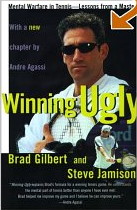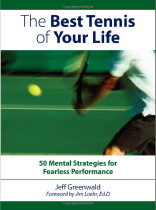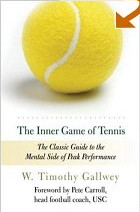April 30, 2000 Article Latest Between The Lines Article Between The Lines Archives:
Tennis Server
|

 |
The current year's men's doubles race has an unfamiliar look at the top, a product of the retirement of the great Jacco Elting at the end of 1998 and the recent physical troubles of Mahesh Bhupathi, half of 1999's top-ranking pair. Sadly, doubles continues to be a rarity on TV, late results are hard to find, and coherent discussion of current rankings is seldom offered. Thus pro-tennis fans can scarcely be blamed for their faint interest in following the game that most of them prefer as players.
THE AUSTRALIAN SEASONThe tune-up events preceding the this year's Australian Open went to two veteran pairs. Australians Woodforde and Woodbridge"the Woodys"won the tournaments at Adelaide and Sydney, while South African star Ellis Ferreira and American Rick Leach captured the event in Auckland, New Zealand. The fast start by the Woodys seemingly reflected Mark Woodforde's declaration last fall to make doubles his top tennis priority.Both the Woodys and Ferreira-Leach then moved successfully through the first four rounds of the Australian Open. In their semi-final showdown, Ferreira-Leach defeated the Woodys, two sets to one. Advancing in the other half of the Melbourne draw were Americans Alex O'Brien and Jared Palmer. O'Brien was now the foremost U.S. doubles specialist, having won the 1999 U.S. Open and the late-year world championship event at Hartford, both with Canadian Sebastien Lareau, and having been Sampras's partner in winning the only U.S. point in the 1999 Davis Cup loss to Australia. The recent split-up of O'Brien and Lareau had been partly rooted in the idea of creating a superior all-U.S. pair (O'Brien-Palmer) for the year of the Olympics. But the new American pairing now lost in the semis at Melbourne Park, to Zimbabwean Wayne Black and Australian Andrew Kratzman. Then, in an extended five-setter remindful of times past, the all-lefty pair of Ferreira-Leach won the year's first Slam, defeating Black-Kratzman, 18-16 in the fifth. Ferreira-Leach thus took the early lead in the year's ATP points race.
DAVIS CUP, FEBRUARYDoubles captures well the team aspect of Davis Cup play. Coming as the third of the five matches in each Cup engagement, the doubles match is always meaningful and is often critical to the team outcome. Drama of high order was indeed seen in the Cup doubles between the U.S. and Zimbabwe in Harare, where Zimbabweans Wayne Black and Kevin Ullyett defeated O'Brien and Rick Leach in five emotion-draining sets. Meanwhile in Switzerland, despite Australia's array of top doubles talent, somehow the Aussies lost the doubles point to the hosts, Arthurs-Stolle losing to Federer-Manta. Thus both the Australians and the Americans entered the third day of their engagements just one match from elimination. Both favored teams managed to survive, however, by winning their final two singles matches.Meanwhile at the other six World Group locales, doubles outcomes either completed or set the stage for team victories. Most interesting was the four-set doubles win of Czechs Novak and Rikl against Henman-Broad of Britain, leading to Czech triumph the next day.
THE INDOOR AND SPRING CIRCUITSThe fine South African pair of Adams-de Jager, after an indifferent January, captured the February indoor tournaments in Rotterdam and London, claiming wins over Novak-Rikl and Henman-Kafelnikov. The South Africans thus moved into third place in the year's race, behind Ferreira-Leach and the Woodys. Also during February Novak-Rikl won the outdoor tournament in Dubai.Two Masters Series events (formerly Super Nines) took place in March at Indian Wells in California, and the Ericsson in Miami. Both were held on paved, outdoor courts. Each carried roughly half the point values awarded in Slams. O'Brien-Palmer triumphed at Indian Wells and reached the semis in Miami, thus rising to third place in the standings, while the Woodys strengthened their second-place hold by reaching the quarters at Indian Wells and then capturing the Ericsson.
DAVIS CUP, APRILThe doubles again shaped the second round of World Group ties. Oncins-Kuerten defeated Kucera-Hrbaty in what became a deciding match in Brazil's 3-2 victory over visiting Slovak Republic. In Spain, Kafelnikov-Safin won Russia's only point. Meanwhile, Australia's Mark Woodforde and Pat Rafter in five sets closed out Australia's win over a depleted German team. Basil Stafford reported from Melbourne that the match had been a strange one. Rafter started slowly but then Woodforde lost all rhythm to yield three consecutive service games. In the fifth set, Woodforde still looked vulnerable in serving but Rafter, according to Basil,"always gave us the difference." Basil summarized: "Full marks to Rafter, who showed what Davis Cup is all about."Meanwhile, the doubles was again a disappointment for the American team, who hosted Czech Republic in Los Angeles. O'Brien-Palmer had been expected to win their match, as they (1) ranked ahead of Novak-Rikl in the ATP standings, (2) had already defeated the Czech pair twice this year, and (3) had the seeming advantage of playing on hard, indoor courts at home. Prior to the start the Americans made known that they planned to "go at" Rikl at net. But that strategy proved ill-advised, as left-hander Rikl proved brilliant in his net play. A still-larger story, however, was the serve-returning of Novak. (Novak, a right-hander with a two-handed backhand, received serve in the ad court.) The early statistical data showed what seemed an interesting curiosity--that most of the points served to Novak were being won by the Czechs. As the match proceeded, the data grew ever more impressive. The Czechs lost almost all points served to Rikl, but they consistently won a strong majority of Novak-returned points. When it counted, however, Rikl's returning rose enough to score the breaks of serve needed to win all three sets. Similarly, although Rikl's serving plainly lacked the weight of Novak's, it held up adequately. O'Brien and Palmer played well on many points, but both Americans made costly errors at critical times. Although the U.S. came away with the team victory thanks to wins by both Agassi and Sampras on the third day, the repeated American failure in Cup doubles demanded attention. The O'Brien-Palmer pairing had been the eleventh different U.S. combination in the last eleven Cup engagements. In those eleven doubles contests, the American won-lost record was a dismal 3-8. U.S. team captain John McEnroe talked about the situation in a mid-April telephone session with reporters. Looking ahead to the July engagement in Spain, McEnroe, it was clear, was no longer thinking of two pure doubles specialists. The captain talked of using Sampras or Agassi in doubles, even though that player would have to compete on three consecutive days. Playing in the doubles would provide a superb opportunity for Sampras, McEnroe conjectured, and he remarked that Agassi's serve-returning skills would be valuable in doubles on Spanish clay. He also mentioned that he would like to have a third singles player on the four-man playing squad as backup for Sampras and Agassi in singles and possibly playing in the doubles, and he specifically mentioned Todd Martin or Jim Courier as possibilities for that role. That Agassi-Sampras might be the U.S. doubles team was not discussed. When asked , the captain did not rule out the idea that John McEnroe might some day again play doubles for the U.S., but he said this would only happen if the captain was fully convinced it was best for the team. I kept silent with my misgivings, but last year I watched McEnroe play doubles in a senior competition in Richmond, where it was obvious that the McEnroe of that week could only embarrass himself in Cup competition.
THE EARLY CLAY EVENTSThe Monte Carlo Open, the first of the clay Masters events, brought together all the top pairs mentioned above except the Woodys. But when the final day arrived at Monte Carlo, none of the leaders were still standing.Paul Haarhuis and Sandon Stolle, both veterans of the doubles wars, began playing together as partners at this year's Indian Wells. Netherlander Haarhuis had been several times world's champion as partner for countryman Eltingh, while Stolle, at 6'4", was a former U.S. Open doubles champion and a regular among the world's top pairs. The new combination, Haarhuis-Stolle, reached the finals at Indian Wells and the quarters at the Ericsson, recording wins over Ferreira-Leach and O'Brien-Palmer. Now at Monte Carlo, Haarhuis-Stolle defeated four opponents including Novak-Rikl to reach the final. Their opponents would be a rarity--a pair of singles stars who also compete regularly in doubles. South African Wayne Ferreira (no relation to Ellis Ferreira) and Russian Yevgeny Kafelnikov had played together occasionally over the years, and in three earlier events this year -- the Australian, Indian Wells, and the Ericsson--they achieved a 5-3 mark including a win over O'Brien-Palmer. Ferreira is primarily a baseliner in singles, twice a Wimbledon and once a U.S. Open semifinalist in doubles, who delivers his groundstrokes with major backswing, scarcely a conventional weapon in doubles. Singles superstar Kafelnikov is a top doubles warrior, winner of two French and one U.S Opens with partner Daniel Vacek. Now, Ferreira-Kafelnikov reached the Monte Carlo final by defeating top-seeded O'Brien-Palmer in straight sets. Then, in the cool Sunday drizzle overlooking the Mediterranean at Monte Carlo, Wayne Ferreira and Kafelnikov defeated Haarhuis-Stolle, 6-3 2-6 6-1. The year's rankings in tour points thus became:
THE WOMEN'S DOUBLESWatching women's doubles can be highly entertaining. Individual points tend to be longer than in men's doubles and shorter than in women's singles, in both cases to the benefit of the spectator.Last year, the Big Four in women's singles also dominated in doubles. Martina Hingis and Lindsay Davenport each won a doubles Slam with other partners, while the Williams sisters together won the French and U.S. Opens. But in year 2000 these young superstars -- Davenport at 23 is the oldest of the four -- are being challenged by several older doubles experts. Injuries partly explain events -- Venus Williams has been inactive, while Serena Williams and Davenport have been intermittently sidelined. The champions of this year's Australian Open were American Lisa Raymond, 26, and Australian Rennae Stubbs, 28. Raymond and Stubbs both exhibit many doubles victories over the years, and are now in their third year as regular partners. The pair survived a close two-settter against Kournikova-Schett in the semis at Melbourne Park, and then defeated Hingis and her new partner, Mary Pierce, in a three-set final. A week later, Hingis-Pierce reversed the outcome, defeating Raymond-Stubbs in straight sets at the Pan Pacific in Tokyo, the first of the year's Tier Ones. The defending Wimbledon champions are Lindsay Davenport and her partner, Corina Morariu, 5'8" and age 21. The pair reached the semis at Melbourne this year. In the Tier One tournament at Indian Wells, Davenport-Morariu overcame Hingis-Pierce in a three-set semi, and then went on to a comfortable win in the final over Kournikova and veteran Natasha Zvereva. Two weeks later at the Tier One Ericsson in Florida, the winners were Julie Halard-Decugis, 29, and Ai Sugiyama, 24. Halard-Decugis and Sugiyama had already earned good credentials for 2000 -- they won the Sydney International in January, defeating Hingis-Pierce, and reached the quarters at Melbourne Park, losing to Davenport-Morariu in three sets. Halard-Decugis also won two other tournaments with other partners--the Paris indoors, and the hard-court event at Chennai, India. Here then are the top pairs for 2000, as of May 1, in WTA points:
Tennis fans can look forward to one other doubles pleasure. Martina Navratilova intends to emerge from retirement in order to compete in the grass tournament at Eastbourne this spring. Her partner, Marianne de Swardt, is a heavy-hitting doubles star who won the Eastbourne doubles two years ago. A main-draw entry at Wimbledon is expected. If so, I would give a lot to be there. --Ray Bowers
1995 - May 1998 | August 1998 - 2003 | 2004 - 2015
This column is copyrighted by Ray Bowers, all rights reserved.
Following interesting military and civilian careers, Ray became a regular
competitor in the senior divisions, reaching official rank of #1 in the 75
singles in the Mid-Atlantic Section for 2002. He was boys' tennis coach for four
years at Thomas Jefferson High School for Science and Technology, Virginia, where
the team three times reached the state Final Four. He was named Washington
Post All-Metropolitan Coach of the Year in 2003. He is now researching a history
of the early pro tennis wars, working mainly at U.S. Library of Congress. A
tentative chapter, which appeared on Tennis Server, won a second-place award
from U.S. Tennis Writers Association.
Questions and comments about these columns can be directed to Ray by using this form.
|



October 2022 Tennis Anyone: Patterns in Doubles by John Mills. September 2022 Tennis Anyone: Short Court by John Mills. |
 You will join 13,000 other subscribers in receiving news of updates to the Tennis Server along with monthly tennis tips from tennis pro Tom Veneziano.
You will join 13,000 other subscribers in receiving news of updates to the Tennis Server along with monthly tennis tips from tennis pro Tom Veneziano. 